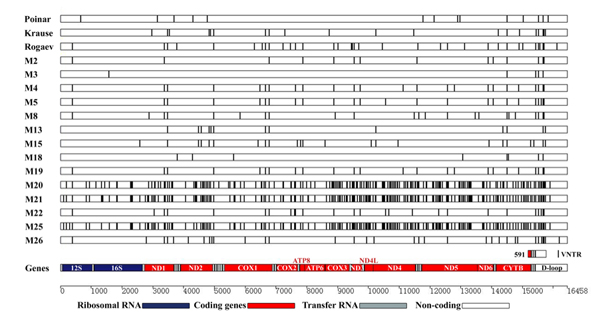 |
Did we sequence more than one kind of mammoth? As a prelude to sequencing
the mammoth genome, we tested a number of mammoth specimens to see
which ones had the best-preserved DNA. For each of these samples we
tried to get enough DNA to assemble a complete mitochondrial sequence
(a tiny piece of DNA that is easy to sequence because each cell has
many copies of it). We were successful for 15 of the samples. When
we identified positions where the new mitochondrial sequences
and three previously published sequences differed from the sequence
of the new specimen called M1, this is what we saw: |
| Each tiny vertical line indicates
a difference from the M1 sequence. Clearly the specimens called M20, M21,
and M25 are very different from the others. Using rigorous computational
methods we determined that the two sets of mitochondrial sequences
separated between 1 million and 2 million years ago.
However, that analysis considers only a tiny piece of DNA (the nuclear genome is about 200,000 times larger) that is inherited in an extremely unusual manner (i.e., only from the mother). We were very interested in seeing whether an analysis of all the DNA would confirm this division into two groups of mammoths. To do this, we looked for genomic positions where M4's nucleotide differed from the sequence of African elephant, as confirmed by at least two independent readings of that mammoth position. (Requiring two readings greatly reduced the chances of the difference being merely a sequencing error.) We then restricted our analysis to cases where we had sequence from the M25 sample. M25 had the same nucleotide as elephant in 13.3% of the cases (i.e., 327 of 2451), and the same nucleotide as M4 the rest of the time. This fraction is very close to what we observed for the mitochondrial sequences, where M25 agreed with African elephant for 14.5% of the elephant-M4 differences. That is, we see the same level of difference between the two groups of mammoths when we look at the nuclear genome. As far as we can tell from the limited data, the group of mammoths that M25 belonged to was extinct by 50,000 years ago, which is about as far back as carbon-14 dating can work. Since there is no evidence that humans inhabited that part of Siberia until much more recently, it appears that the group vanished without ever being hunted by man. We hope to learn whether the substantial difference in DNA between the two groups of mammoths actually created distinct species, or whether this process was terminated by premature extinction of M25's clade. |
 |
